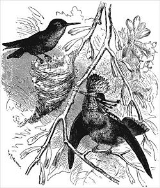
Sexual selection
Encyclopedia
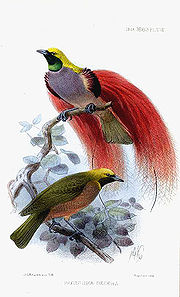
Charles Darwin
Charles Robert Darwin FRS was an English naturalist. He established that all species of life have descended over time from common ancestry, and proposed the scientific theory that this branching pattern of evolution resulted from a process that he called natural selection.He published his theory...
in his 1859 book On the Origin of Species, is a significant element of his theory of natural selection
Natural selection
Natural selection is the nonrandom process by which biologic traits become either more or less common in a population as a function of differential reproduction of their bearers. It is a key mechanism of evolution....
. The sexual form of selection
His sexual selection examples include ornate peacock feathers, birds of Paradise, the antlers of stag
Deer
Deer are the ruminant mammals forming the family Cervidae. Species in the Cervidae family include white-tailed deer, elk, moose, red deer, reindeer, fallow deer, roe deer and chital. Male deer of all species and female reindeer grow and shed new antlers each year...
(male deer), and the manes of lions.
Darwin greatly expands his initial three-page treatment of Sexual Selection in the 1871 book The Descent of Man and Selection in Relation to Sex. This 900-page, two-volume work includes 70 pages on sexual selection in human evolution, and 500 pages on sexual selection in other animals. In summary, while natural selection results from the struggle to survive, sexual selection emerges from the struggle to reproduce.
Concept
The sexual selection concept arises from the observation that many animals develop features whose function is not to help individuals survive, but help them to maximize their reproductive successReproductive success
Reproductive success is defined as the passing of genes onto the next generation in a way that they too can pass those genes on. In practice, this is often a tally of the number of offspring produced by an individual. A more correct definition, which incorporates inclusive fitness, is the...
. This can be realized in two different ways:
- by making themselves attractive to the opposite sex (intersexual selection, between the sexes); or
- by intimidating, deterring or defeating same-sex rivals (intrasexual selection, within a given sex).
Thus, sexual selection takes two major forms: intersexual selection (also known as 'mate choice
Mate choice
Mate choice, or intersexual selection, is an evolutionary process in which selection of a mate depends on attractiveness of its traits. It is one of two components of sexual selection...
' or 'female choice') in which males compete with each other to be chosen by females; and intrasexual selection (also known as 'male–male competition') in which members of the less limited sex (typically males) compete aggressively among themselves for access to the limiting sex. The limiting sex is the sex which has the higher parental investment, which therefore faces the most pressure to make a good mate decision.
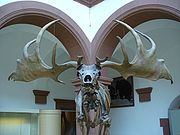
Species
In biology, a species is one of the basic units of biological classification and a taxonomic rank. A species is often defined as a group of organisms capable of interbreeding and producing fertile offspring. While in many cases this definition is adequate, more precise or differing measures are...
, intrasexual selection drives the selection of attributes that allow alpha males to dominate their own breeding partners and rivals.
Sexual selection sometimes creates monstrously absurd features that, in harder times, could help cause a species' extinction, as has been suggested for the giant antlers of the Irish Elk (Megaloceros giganteus) that became extinct in Pleistocene
Pleistocene
The Pleistocene is the epoch from 2,588,000 to 11,700 years BP that spans the world's recent period of repeated glaciations. The name pleistocene is derived from the Greek and ....
Europe. However, sexual selection can also do the opposite, driving species divergence - sometimes through elaborate changes in genitalia - such that new species emerge.
Although the driving force for both sexes is reproductive success, the two genders have different concerns: males may seek to monopolize access to a group of fertile females, while the females want to maximize return on the energy they invest in reproduction, seeing their offspring grow into healthy adults - and especially into alpha males with well-developed, sexually attractive features that sire
Father
A father, Pop, Dad, or Papa, is defined as a male parent of any type of offspring. The adjective "paternal" refers to father, parallel to "maternal" for mother...
them many descendants. Because of their limited number of breeding opportunities (due to seasonal breeding cycles, limited litter sizes, and the amount of food available to bring up the offspring) females have much more reason to be "picky". They need a way to choose the males that are most capable. Male and female investments in rearing offspring are not equal, females' energy expenditures on gestation and parental care being much higher. In contrast, males often use every opportunity they have to mate, as they are less invested in each individual offspring.
An example: the giraffe
Recently, there has been some controversy regarding the evolutionary origins of the giraffeGiraffe
The giraffe is an African even-toed ungulate mammal, the tallest of all extant land-living animal species, and the largest ruminant...
(Giraffa camelopardalis) neck. The long accepted "competing browser's hypothesis" by Charles Darwin
Charles Darwin
Charles Robert Darwin FRS was an English naturalist. He established that all species of life have descended over time from common ancestry, and proposed the scientific theory that this branching pattern of evolution resulted from a process that he called natural selection.He published his theory...
is now being put into question. Originally scientists believed that the elongation of the giraffe's neck had been a result of foraging
Foraging
- Definitions and significance of foraging behavior :Foraging is the act of searching for and exploiting food resources. It affects an animal's fitness because it plays an important role in an animal's ability to survive and reproduce...
selection. It was said that millions of years ago when the giraffe first appeared these animals had a variation of neck lengths. However, because of the fierce competition between the giraffe and rival foragers, those with the shorter necks could only find food at the level rivals were also feeding at. Fortunately, the giraffes with long necks had a larger range of food choice (based on height) and thus lived longer and this trait was selected for through natural selection
Natural selection
Natural selection is the nonrandom process by which biologic traits become either more or less common in a population as a function of differential reproduction of their bearers. It is a key mechanism of evolution....
.
Nowadays it has been observed that even though the giraffe’s overall height is actually about 6 meters, it still feeds at 2 meters above the ground. Moreover, the kudu, impala, and steenbok competitors do not feed above 2 meters and prefer feeding at shoulder level as well. This is peculiar since their necks would allow them to feed at much greater heights.
Another explanation as to where the giraffe's neck came from is sexual selection. It is known that males will often neck with other males in order to exhibit dominance. There are six criteria that need to be satisfied for the exaggerated neck to be classified as a result of sexual selection. Theoretically, the characteristic should be more exaggerated in one of the sexes; it must be used to indicate dominance; have no direct survival benefits; help the organism gain survival costs; positive allometry should be observed. For instance, evolution history shows increased neck length not correlated to increases in other parts of the body, which is what would be expected in foraging selection.
There are still contradictory information in this field of study. Although studies have been published that support foraging selection or sexual selection, not many have decisively eliminated other possibilities. Perhaps the neck was a result of both forces. One must take into account parental investment and anachronism as well in order to make a clear verdict. However, there has been little luck in getting closer to the true answer. Especially because there are almost 10 million years worth of fossil records missing.
Nonetheless, both males and females put a considerable amount of energy into the formation and maintenance of the neck. Unquestionably, such an evolved organism would not spend so many resources on a characteristic if it were not pertinent to their survival and fitness.
Modern Interpretation
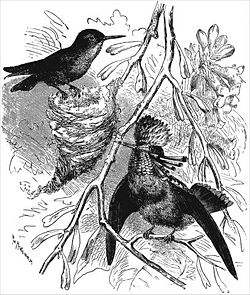
Intraspecific competition
Intraspecific competition is a particular form of competition in which members of the same species vie for the same resource in an ecosystem...
- competition between members of the same species - distinguishing between competition before or after sexual intercourse
Sexual intercourse
Sexual intercourse, also known as copulation or coitus, commonly refers to the act in which a male's penis enters a female's vagina for the purposes of sexual pleasure or reproduction. The entities may be of opposite sexes, or they may be hermaphroditic, as is the case with snails...
.
- Before copulationSexual intercourseSexual intercourse, also known as copulation or coitus, commonly refers to the act in which a male's penis enters a female's vagina for the purposes of sexual pleasure or reproduction. The entities may be of opposite sexes, or they may be hermaphroditic, as is the case with snails...
, intrasexual selection - usually between males - may take the form of male-to-male combat. Also, intersexual selection, or mate choiceMate choiceMate choice, or intersexual selection, is an evolutionary process in which selection of a mate depends on attractiveness of its traits. It is one of two components of sexual selection...
, occurs when females choose between male mates. Traits selected by male combat are called secondary sexual characteristics (including horns, antlers, etc.), which Darwin described as "weapons", while traits selected by mate (usually female) choice are called "ornaments".
- After copulation, male–male competition distinct from conventional aggression may take the form of sperm competitionSperm competitionSperm competition is a term used to refer to the competitive process between spermatozoa of two different males to fertilize an egg of a lone female. Competition occurs whenever females engage in promiscuous mating to increase their chances in producing more viable offspring...
, as described by ParkerGeoff ParkerProfessor Geoffrey Alan Parker FRS is a Derby professor of biology at the University of Liverpool.He has a particular interest in behavioural ecology and evolutionary biology, and is most noted for introducing the concept of sperm competition in 1970.Much of his work from the 1970s onwards has...
in 1970. More recently, interest has arisen in cryptic female choiceFemale sperm storageFemale sperm storage is a biological process in which sperm cells transferred to a female during mating are temporarily retained within a specific part of the reproductive tract before the oocyte, or egg, is fertilized...
, a phenomenon of internally fertilised animals such as mammals and birds, where a female will get rid of a male's spermSpermThe term sperm is derived from the Greek word sperma and refers to the male reproductive cells. In the types of sexual reproduction known as anisogamy and oogamy, there is a marked difference in the size of the gametes with the smaller one being termed the "male" or sperm cell...
without his knowledge.
Finally, sexual conflict
Sexual conflict
Sexual conflict occurs when the two sexes have conflicting optimal fitness strategies concerning reproduction, particularly the mode and frequency of mating, leading to an evolutionary arms race between males and females. The conflict encompasses the actions and behaviors of both sexes to influence...
is said to occur between breeding partners, sometimes leading to an evolutionary arms race
Evolutionary arms race
In evolutionary biology, an evolutionary arms race is an evolutionary struggle between competing sets of co-evolving genes that develop adaptations and counter-adaptations against each other, resembling an arms race, which are also examples of positive feedback...
between males and females.
Female mating preferences are widely recognized as being responsible for the rapid and divergent evolution of male secondary sexual traits. Females of many animal species prefer to mate with males with external ornaments - exaggerated features of morphology such as elaborate sex organs. These preferences may arise when an arbitrary female preference for some aspect of male morphology — initially, perhaps, a result of genetic drift
Genetic drift
Genetic drift or allelic drift is the change in the frequency of a gene variant in a population due to random sampling.The alleles in the offspring are a sample of those in the parents, and chance has a role in determining whether a given individual survives and reproduces...
— creates, in due course, selection for males with the appropriate ornament. One interpretation of this is known as the sexy son hypothesis
Sexy son hypothesis
The sexy son hypothesis of evolutionary biology was first proposed by Patrick J. Weatherhead and Raleigh J. Robertson of Queen's University in 1979. It proposes that a female animal's optimal choice among potential mates is a male whose genes will produce male offspring with the best chance of...
. Alternatively, genes that enable males to develop impressive ornaments or fighting ability may simply show off greater disease resistance
Immune system
An immune system is a system of biological structures and processes within an organism that protects against disease by identifying and killing pathogens and tumor cells. It detects a wide variety of agents, from viruses to parasitic worms, and needs to distinguish them from the organism's own...
or a more efficient metabolism
Metabolism
Metabolism is the set of chemical reactions that happen in the cells of living organisms to sustain life. These processes allow organisms to grow and reproduce, maintain their structures, and respond to their environments. Metabolism is usually divided into two categories...
, features that also benefit females. This idea is known as the good genes hypothesis.
Criteria for reproductive success
The success of an organism is not only measured by the number of offspring left behind, but by the quality or probable fitness of the offspring: their reproductive fitnessReproductive success
Reproductive success is defined as the passing of genes onto the next generation in a way that they too can pass those genes on. In practice, this is often a tally of the number of offspring produced by an individual. A more correct definition, which incorporates inclusive fitness, is the...
.
Sexual selection increases the ability of organisms to differentiate one another at the species level: interspecies selection.
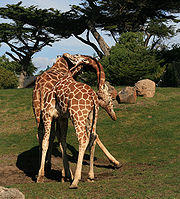
The expansion of interspecies selection and intraspecies selection is a driving force behind species fission: the separation of a single contiguous species into multiple non-contiguous variants. Sexual preference creates a tendency towards assortative mating
Assortative mating
Assortative mating , and the related concept Disassortative mating, is the phenomenon where a sexually reproducing organism chooses to mate with individuals that are similar or dissimilar to itself in some specific manner...
or homogamy
Homogamy
-In sociology:Homogamy is marriage between individuals who are, in some culturally important way, similar to each other. Homogamy may be based on socio-economic status, class, gender, ethnicity, or religion...
, providing a system by which a group otherwise invaded by diverse genes is able to suppress their effects and diverge genetically.
The general conditions of sexual discrimination appear to be (1) the acceptance of one mate precludes the effective acceptance of alternative mates, and (2) the rejection of an offer will be followed by other offers, either certainly, or at such high chance that the risk of non-occurrence will be smaller than the chance advantage to be gained by selecting a mate.
Example: Intersexual Selection
The conditions determining which sex becomes the more limited resource in intersexual selection can be best understood by way of Bateman's principleBateman's principle
In biology, Bateman's principle is the theory that females almost always invest more energy into producing offspring than males invest, and therefore in most species females are a limiting resource over which the other sex will compete...
which states that the sex which invests the most in producing offspring becomes a limiting resource over which the other sex will compete. This can be most easily illustrated by the contrast in nutritional investment into a zygote
Zygote
A zygote , or zygocyte, is the initial cell formed when two gamete cells are joined by means of sexual reproduction. In multicellular organisms, it is the earliest developmental stage of the embryo...
between egg and sperm, and the limited reproductive capacity of females compared to males. Thus, 'sexual selection' typically refers to the process of choice (the limiting factor, which is typically females) over members of the opposite sex (the non-limited factor, typically males).
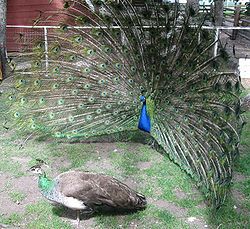
Peafowl
Peafowl are two Asiatic species of flying birds in the genus Pavo of the pheasant family, Phasianidae, best known for the male's extravagant eye-spotted tail, which it displays as part of courtship. The male is called a peacock, the female a peahen, and the offspring peachicks. The adult female...
provides a particularly well known example of intersexual selection, where ornate males compete to be chosen by females. The result is a stunning feathered display, which is large and unwieldy enough to pose a significant survival disadvantage. Biologists have suggested that the layers of the ornate plumage of males provide a means of demonstrating body symmetry, such that peahens are "trying" to discover the health of the male or the quality of his genes. Diseases, injuries, and genetic disorders may impair the body's symmetry. There is also evidence that reduced symmetry of males may result in fewer offspring, or allow males access only to females with lesser parenting skills.
Bird species often demonstrate intersexual selection, perhaps because - due to their lightweight body structures - fights between males may be ineffective or impractical. Therefore, male birds commonly use the following methods to try to seduce the females:
- Colour: Some species have ornate, diverse, and often colourful feathers.
- Song: male birdsong provides an important way of protecting territory (intrasexual selection).
- Nest construction: In some species, males build nests that females subject to rigorous inspection, choosing the male that makes the most attractive nest.
- Dance: Males dance in front of females. Cranes provide a well known example.
Exponential growth in female preference
In species where intersexual selection is active, as in many polygamous birds, sexual selection acts by accelerating the preference that specific "fashion" ornaments attract, causing the preferred trait and female preference for it to increase together, explosively. While Darwin had been criticised for simply accepting female whims as given, Ronald Fisher grasped the underlying mechanism in The Genetical Theory of Natural SelectionThe Genetical Theory of Natural Selection
The Genetical Theory of Natural Selection is a book by R.A. Fisher first published in 1930 by Clarendon. It is one of the most important books of the modern evolutionary synthesis and is commonly cited in biology books.-Editions:...
, in a remark was not widely understood for another 50 years:
Fisher's runaway
Fisherian runaway
Fisherian runaway is a model of sexual selection, first proposed by R.A. Fisher in 1915, and expanded upon in his 1930 book The Genetical Theory of Natural Selection, that suggests an explanation for sexual selection of traits that do not obviously increase fitness of survival, based upon a...
process causes a dramatic increase in both the male's conspicuous feature and in female preference for it, until practical, physical constraints halt further exaggeration. A positive feedback
Positive feedback
Positive feedback is a process in which the effects of a small disturbance on a system include an increase in the magnitude of the perturbation. That is, A produces more of B which in turn produces more of A. In contrast, a system that responds to a perturbation in a way that reduces its effect is...
loop is created, producing extravagant physical structures in the non-limiting sex, such as in the male African Long-Tailed Widow Bird (left). While males have long tails, female tastes in tail length are still more extreme. Fisher understood that female preference for long tails may be passed on genetically, in conjunction with genes for the long tail itself. Long-Tailed Widow Bird offspring of both sexes will inherit both sets of genes, with females expressing
Gene expression
Gene expression is the process by which information from a gene is used in the synthesis of a functional gene product. These products are often proteins, but in non-protein coding genes such as ribosomal RNA , transfer RNA or small nuclear RNA genes, the product is a functional RNA...
their genetic preference for long tails, and males showing off the coveted long tail itself.
Richard Dawkins
Richard Dawkins
Clinton Richard Dawkins, FRS, FRSL , known as Richard Dawkins, is a British ethologist, evolutionary biologist and author...
presents a non-mathematical explanation of the runaway sexual selection process in his book The Blind Watchmaker
The Blind Watchmaker
The Blind Watchmaker: Why the Evidence of Evolution Reveals a Universe without Design is a 1986 book by Richard Dawkins in which he presents an explanation of, and argument for, the theory of evolution by means of natural selection. He also presents arguments to refute certain criticisms made on...
. Females who prefer long tailed males tend to have mothers that chose long-tailed fathers. As a result, they carry both sets of genes in their bodies. That is, genes for long tails and for preferring long tails become linked
Linkage disequilibrium
In population genetics, linkage disequilibrium is the non-random association of alleles at two or more loci, not necessarily on the same chromosome. It is also referred to as to as gametic phase disequilibrium , or simply gametic disequilibrium...
. The taste for long tails and tail length itself may therefore become correlated, tending to increase together. The more tails lengthen, the more long tails are desired. Any slight initial imbalance between taste and tails may set off an explosion in tail lengths. Fisher corresponded that:
The female widow bird will desire to mate with the most attractive long-tailed male so that her progeny, if male, will themselves be attractive to females of the next generation - thereby fathering many offspring who will carry the female's genes. Since the rate of change in preference is proportional to the average taste amongst females, and as females desire to secure the services of the most sexually attractive males, an additive effect is created that, if unchecked, can yield exponential increases in a given taste and in the corresponding desired sexual attribute.
Since Fisher's initial conceptual model of the 'runaway' process, Russell Lande and Peter O'Donald have provided detailed mathematical proofs that define the circumstances under which runaway sexual selection can take place.
Example: Intrasexual selection
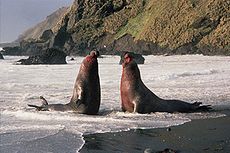
Harem
Harem refers to the sphere of women in what is usually a polygynous household and their enclosed quarters which are forbidden to men...
of females, is the elephant seal
Elephant seal
Elephant seals are large, oceangoing seals in the genus Mirounga. There are two species: the northern elephant seal and the southern elephant seal . Both were hunted to the brink of extinction by the end of the 19th century, but numbers have since recovered...
- large, oceangoing mammals of the genus
Genus
In biology, a genus is a low-level taxonomic rank used in the biological classification of living and fossil organisms, which is an example of definition by genus and differentia...
Mirounga. There are two species: the northern
Northern Elephant Seal
The northern elephant seal is one of two species of elephant seal . It is a member of the family Phocidae . Elephant seals derive their name from their great size and from the male's large proboscis, which is used in making extraordinarily loud roaring noises, especially during the mating...
(M. angustirostris) and southern elephant seal
Southern Elephant Seal
The Southern Elephant Seal is one of the two extant species of elephant seal. It is both the most massive pinniped and member of the order Carnivora living today...
(M. leonina) - the largest carnivore
Carnivora
The diverse order Carnivora |Latin]] carō "flesh", + vorāre "to devour") includes over 260 species of placental mammals. Its members are formally referred to as carnivorans, while the word "carnivore" can refer to any meat-eating animal...
living today. Both species show extreme sexual dimorphism
Sexual dimorphism
Sexual dimorphism is a phenotypic difference between males and females of the same species. Examples of such differences include differences in morphology, ornamentation, and behavior.-Examples:-Ornamentation / coloration:...
, possibly the largest of any mammal, with southern males typically five to six times heavier than the females.
While the females average 400 to 900 kg (881.8 to 1,984.2 lb) and 2.6 to 3 m (8.5 to 9.8 ft) long, the bulls average 2200 to 4000 kg (4,850.2 to 8,818.5 lb) and 4.2 to 5 m (13.8 to 16.4 ft) long.
The record-sized bull, shot in Possession Bay, South Georgia
South Georgia and the South Sandwich Islands
South Georgia and the South Sandwich Islands is a British overseas territory and overseas territory of the European Union in the southern Atlantic Ocean. It is a remote and inhospitable collection of islands, consisting of South Georgia and a chain of smaller islands, known as the South Sandwich...
, on February 28, 1913, measured 6.85 metres (22.5 ft) long and was estimated to weigh 5000 kilograms (11,023.1 lb). The maximum weight of a female is 1000 kilograms (2,204.6 lb) with a length of 3.7 metres (12.1 ft).
Males arrive in the colonies before the females and fight for control of harems. Large body size confers advantages in fighting. The agonistic behaviour
Agonistic behaviour
In ethology, agonistic behaviour is any social behaviour related to fighting. Thus it is broader than aggressive behaviour because it includes not only actual aggression but also threats, displays, retreats, placating aggressors, and conciliation. The term was coined by Scott and Fredericson in 1951...
of the bulls gives rise to a dominance hierarchy, with access to harems and breeding activity being determined by rank. The dominant bulls or “harem masters” establish harems of several dozen females. The least successful males have no harems, but may try to copulate with a harem male's females when the dominant male is not looking. A dominant male must stay in his territory to defend it, which can mean months without eating, living on his store of blubber. Some males have stayed ashore for more than three months without food. Two fighting males use their weight and canine teeth against each other. The outcome is rarely fatal, and the defeated bull will flee; however, bulls suffer severe tears and cuts. Males commonly vocalize with a coughing roar that serves in both individual recognition and size assessment. Conflicts between high ranking males are more often resolved with posturing and vocalizing than with physical contact.
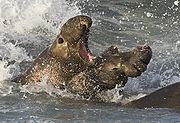
Signalling theory
Within evolutionary biology, signalling theory is a body of theoretical work examining communication between individuals. The central question is when organisms with conflicting interests should be expected to communicate "honestly"...
to create a dominance hierarchy
Dominance hierarchy
A dominance hierarchy is the organization of individuals in a group that occurs when competition for resources leads to aggression...
among males, also known as a pecking order
Pecking order
Pecking order or just peck order is the colloquial term for a hierarchical system of social organization in chickens. It was first described from the behaviour of poultry by Thorleif Schjelderup-Ebbe in 1921 under the German terms Hackordnung or Hackliste' ...
, allows struggle to proceed without excessive injury or fatality. It is predominantly when two opposing males are so closely matched, as would be found in males not having established themselves in a dominance hierarchy, that asymmetries cannot be found and the confrontation escalates to a point where the asymmetries must be proved by aggressive use of ornamentation.
How often males will physically engage each other, and in what manner, can best be understood by applying game theory
Game theory
Game theory is a mathematical method for analyzing calculated circumstances, such as in games, where a person’s success is based upon the choices of others...
developed for biology, most notably by John Maynard Smith
John Maynard Smith
John Maynard Smith,His surname was Maynard Smith, not Smith, nor was it hyphenated. F.R.S. was a British theoretical evolutionary biologist and geneticist. Originally an aeronautical engineer during the Second World War, he took a second degree in genetics under the well-known biologist J.B.S....
.
Sexual dimorphism
Sex differences directly related to reproduction and serving no direct purpose in courtship are called primary sexual characteristics. Traits amenable to sexual selection, which give an organism an advantage over its rivals (such as in courtship) without being directly involved in reproduction, are called secondary sex characteristicSecondary sex characteristic
Secondary sex characteristics are features that distinguish the two sexes of a species, but that are not directly part of the reproductive system. They are believed to be the product of sexual selection for traits which give an individual an advantage over its rivals in courtship and aggressive...
s.
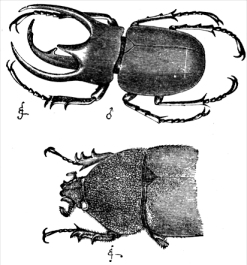
Nash equilibrium
In game theory, Nash equilibrium is a solution concept of a game involving two or more players, in which each player is assumed to know the equilibrium strategies of the other players, and no player has anything to gain by changing only his own strategy unilaterally...
strategies, due to a difference in relative investment in producing offspring. As formulated in Bateman's principle, females have a greater initial investment in producing offspring (pregnancy
Pregnancy
Pregnancy refers to the fertilization and development of one or more offspring, known as a fetus or embryo, in a woman's uterus. In a pregnancy, there can be multiple gestations, as in the case of twins or triplets...
in mammals or the production of the egg in birds and reptiles) , and this difference in initial investment creates differences in variance in expected reproductive success and bootstraps the sexual selection processes. Classic examples of reversed sex-role species include the pipefish
Pipefish
Pipefishes or pipe-fishes are a subfamily of small fishes, which, together with the seahorses, form the family Syngnathidae.-Anatomy:...
, and Wilson's phalarope. Also, unlike a female, a male (except in monogamous species) has some uncertainty about whether or not he is the true parent of a child, and so will be less interested in spending his energy helping to raise offspring that may or may not be related to him. As a result of these factors, males are typically more willing to mate than females, and so females are typically the ones doing the choosing (except in cases of forced copulations, which can occur in certain species of primate
Primate
A primate is a mammal of the order Primates , which contains prosimians and simians. Primates arose from ancestors that lived in the trees of tropical forests; many primate characteristics represent adaptations to life in this challenging three-dimensional environment...
s, duck
Duck
Duck is the common name for a large number of species in the Anatidae family of birds, which also includes swans and geese. The ducks are divided among several subfamilies in the Anatidae family; they do not represent a monophyletic group but a form taxon, since swans and geese are not considered...
s, and others). The effects of sexual selection are thus held to typically be more pronounced in males than in females.
Differences in secondary sexual characteristics between males and females of a species are referred to as sexual dimorphism
Sexual dimorphism
Sexual dimorphism is a phenotypic difference between males and females of the same species. Examples of such differences include differences in morphology, ornamentation, and behavior.-Examples:-Ornamentation / coloration:...
s. These can be as subtle as a size difference (sexual size dimorphism, often abbreviated as SSD) or as extreme as horns and color patterns. Sexual dimorphisms abound in nature. Examples include the possession of antlers by only male deer, and the brighter coloration of many male birds, in comparison with females of the same species. The peacock, with its elaborate and colorful tail feathers, which the peahen lacks, is often referred to as perhaps the most extraordinary example of a dimorphism. The largest sexual size dimorphism in vertebrates is the shell dwelling
Shell dwellers
The terms shell dwellers or shelldwellers, shell-breeding, or ostracophil are descriptive terms for cichlid fish that use the empty shells of aquatic snails as sites for breeding and shelter. The terms have no taxonomic basis, although most shell-dwelling cichlids are from Lake Tanganyikas...
cichlid
Cichlid
Cichlids are fishes from the family Cichlidae in the order Perciformes. Cichlids are members of a group known as the Labroidei along with the wrasses , damselfish , and surfperches . This family is both large and diverse. At least 1,300 species have been scientifically described, making it one of...
fish
Fish
Fish are a paraphyletic group of organisms that consist of all gill-bearing aquatic vertebrate animals that lack limbs with digits. Included in this definition are the living hagfish, lampreys, and cartilaginous and bony fish, as well as various extinct related groups...
Neolamprologus callipterus in which males are up to 30 times the size of females. Extreme sexual size dimorphism, with females larger than males, is quite common in spiders.
Sexual selection as a toolkit of natural selection
Critics of evolution have long challenged proponents to explain how animals initially evolved complex organs such as eyes, hands, or feathered wings. There is no doubt that, once developed, each of these organs offers major and obvious advantages. However, it can be difficult to imagine how certain organs' individual components each had distinct survival value at every stage in their evolution. One recent theory sees evolution as an "adventure questAdventure Quest
Adventure Quest may refer to the following games:* AdventureQuest , an online single-player RPG developed by Artix Entertainment in 2002...
" in which species develop complexity and novelty by acquiring modular capabilities through chance encounters in an evolutionary game. But, this still leaves open the question of how evolution initiated each module.
Geoffrey Miller
Geoffrey Miller
Geoffrey Miller may refer to:* Geoff Miller, , English cricketer* Geoffrey D. Miller , general* Geoffrey Miller , evolutionary psychologist-See also:* Jeff Miller...
proposes that sexual selection might have contributed by creating evolutionary modules such as Archaeopteryx
Archaeopteryx
Archaeopteryx , sometimes referred to by its German name Urvogel , is a genus of theropod dinosaur that is closely related to birds. The name derives from the Ancient Greek meaning "ancient", and , meaning "feather" or "wing"...
feathers as sexual ornaments, at first. The earliest proto-birds such as China's Protarchaeopteryx
Protarchaeopteryx
Protarchaeopteryx is a genus of turkey-sized feathered theropod dinosaur from China. Known from the Jianshangou bed of the Yixian Formation, it lived during the early Aptian age of the Early Cretaceous, approximately 124.6 million years ago...
, discovered in the early 1990s, had well-developed feathers but no sign of the top/bottom asymmetry that gives wings lift. Some have suggested that the feathers served as insulation, helping females incubate their eggs. But perhaps the feathers served as the kinds of sexual ornaments still common in most bird species, and especially in birds such as Peacocks and Birds-of-paradise today. If proto-bird courtship displays combined displays of forelimb feathers with energetic jumps, then the transition from display to aerodynamic functions could have been relatively smooth.
Viability and variations of the theory
Due to their sometimes greatly exaggerated nature, secondary sexual characteristics can prove to be a hindrance to an animal, thereby lowering its chances of survival. For example, the large antlers of a moose are bulky and heavy and slow the creature's flight from predators; they also can become entangled in low-hanging tree branches and shrubs, and undoubtedly have led to the demise of many individuals. Bright colorations and showy ornamenations, such as those seen in many male birds, in addition to capturing the eyes of females, also attract the attention of predators; when a male peacock spreads its tail, it is beautiful, but very obvious (though this may actually be advantageous to the survival of the male's offspring and the breeding population as a whole; see below). Some of these traits also represent energetically costly investments for the animals that bear them. Because traits held to be due to sexual selection often conflict with the survival fitness of the individual, the question then arises as to why, in nature, in which survival of the fittestSurvival of the fittest
"Survival of the fittest" is a phrase originating in evolutionary theory, as an alternative description of Natural selection. The phrase is today commonly used in contexts that are incompatible with the original meaning as intended by its first two proponents: British polymath philosopher Herbert...
is considered the rule of thumb, such apparent liabilities are allowed to persist.
An often-cited theory published by R.A. Fisher in 1930 that attempts to resolve the paradox posits that such traits are the results of explosive positive feedback
Positive feedback
Positive feedback is a process in which the effects of a small disturbance on a system include an increase in the magnitude of the perturbation. That is, A produces more of B which in turn produces more of A. In contrast, a system that responds to a perturbation in a way that reduces its effect is...
loops that have as their starting points particular sexual preferences for features that confer a survival advantage and thus "become established in the species." Fisher argued that such features advance in the direction of the preference even beyond the optimal level for survival, until the selection pressure of female choice is precisely counterbalanced by the resultant disadvantage for survival. Fisher further argued that the strength of the female preference tends to grow exponentially (leading to 'explosive' evolution of the characteristic) until finally checked by ecological selection, since the offspring of those females with the strongest preference typically fare better in reproducing than the offspring of females with weaker preferences. Any mutations for the preference opposite to the given characteristic, though tending to promote survival against ecological selection, nevertheless tend not to survive in the gene pool
Gene pool
In population genetics, a gene pool is the complete set of unique alleles in a species or population.- Description :A large gene pool indicates extensive genetic diversity, which is associated with robust populations that can survive bouts of intense selection...
because male offspring that result from mating
Mating
In biology, mating is the pairing of opposite-sex or hermaphroditic organisms for copulation. In social animals, it also includes the raising of their offspring. Copulation is the union of the sex organs of two sexually reproducing animals for insemination and subsequent internal fertilization...
s based on the preference are less sexually attractive to the majority of the females in the population, and thus infrequently chosen as mates. An equivalent way of expressing this is that if most females are looking, for example, for long-tailed males, then each female individually does better to select a long-tailed male, since then her male children are more likely to succeed. (The females do not actually have this thought process; this kind of "decision" is an evolutionarily stable strategy
Evolutionarily stable strategy
In game theory and behavioural ecology, an evolutionarily stable strategy , which is sometimes also called an evolutionary stable strategy, is a strategy which, if adopted by a population of players, cannot be invaded by any alternative strategy that is initially rare. An ESS is an equilibrium...
.)
Other theories highlight intrinsically useful qualities of such traits. Antlers, horns and the like can be used in physical defense from a predator
Predation
In ecology, predation describes a biological interaction where a predator feeds on its prey . Predators may or may not kill their prey prior to feeding on them, but the act of predation always results in the death of its prey and the eventual absorption of the prey's tissue through consumption...
, and also in show jousting
Jousting
Jousting is a martial game or hastilude between two knights mounted on horses and using lances, often as part of a tournament.Jousting emerged in the High Middle Ages based on the military use of the lance by heavy cavalry. The first camels tournament was staged in 1066, but jousting itself did not...
or competition
Competition
Competition is a contest between individuals, groups, animals, etc. for territory, a niche, or a location of resources. It arises whenever two and only two strive for a goal which cannot be shared. Competition occurs naturally between living organisms which co-exist in the same environment. For...
among males in a species. The winner, which typically becomes the dominant animal in the population, is granted access to females, and therefore increases his reproductive output. Antlers are not the only mechanism that can be used to counteract predation. Predators typically look for the eyes of their prey so they can attack that end of the creature. The conspicuousness of eyespots on many species of butterflies and fishes confuses predators and helps to prevent the prey from suffering serious damage.
Another, more recently developed, theory, the Handicap principle
Handicap principle
The handicap principle is a hypothesis originally proposed in 1975 by biologist Amotz Zahavi to explain how evolution may lead to "honest" or reliable signaling between animals who have an obvious motivation to bluff or deceive each other...
of Amotz Zahavi
Amotz Zahavi
Amotz Zahavi is an Israeli evolutionary biologist, a Professor Emeritus at the Zoology Department of Tel Aviv University, and one of the founders of the Society for the Protection of Nature in Israel...
, Russell Lande
Russell Lande
Russell Lande is an American evolutionary biologist and ecologist, and a Royal Society Research Professor at Imperial College London, in Silwood Park.-Education and career:...
and W. D. Hamilton
W. D. Hamilton
William Donald Hamilton FRS was a British evolutionary biologist, widely recognised as one of the greatest evolutionary theorists of the 20th century....
, holds that the fact that the male of the species is able to survive until and through the age of reproduction with such a seemingly maladaptive trait is effectively considered by the female to be a testament to his overall fitness. Such handicaps might prove he is either free of or resistant to disease
Disease
A disease is an abnormal condition affecting the body of an organism. It is often construed to be a medical condition associated with specific symptoms and signs. It may be caused by external factors, such as infectious disease, or it may be caused by internal dysfunctions, such as autoimmune...
, or it might demonstrate that this animal possesses more speed or a greater physical strength that is used to combat the troubles brought on by the exaggerated trait.
Zahavi's work spurred a re-examination of the field, which has produced an ever-accelerating number of theories. In 1984, Hamilton and Marlene Zuk introduced the "Bright Male" hypothesis, suggesting that male elaborations might serve as a marker of health, by exaggerating the effects of disease and deficiency. In 1990, Michael Ryan and A.S. Rand, working with the túngara frog, proposed the hypothesis of "Sensory Exploitation", where exaggerated male traits may provide a sensory stimulation that females find hard to resist. In 1991, Anders Pape Møller, working with the tails of male barn swallows, introduced fluctuating asymmetry
Fluctuating asymmetry
Fluctuating asymmetry is an organism’s deviation from bilateral symmetry. It can be measured in the body—as in bilateral symmetry of finger lengths—or in a particular organ...
to the field. Fluctuating asymmetry, a concept previously invoked under natural selection, is based on the observations that healthier specimens have more left-to-right sided symmetry than less healthy specimens. Subsequently the theories of the "Gravity Hypothesis" by Jordi Moya-Larano et al. and "Chase Away" by Brett Holland and William R. Rice have also been added. In addition, in the late 1970s Janzen and Mary Willson, noting that male flowers are often larger than female flowers, expanded the field of sexual selection into plant
Plant
Plants are living organisms belonging to the kingdom Plantae. Precise definitions of the kingdom vary, but as the term is used here, plants include familiar organisms such as trees, flowers, herbs, bushes, grasses, vines, ferns, mosses, and green algae. The group is also called green plants or...
s.
In the past few years, the field has exploded to include many additional areas of study, not all of which are clearly included under Darwin's definition of sexual selection. These include cuckold
Cuckold
Cuckold is a historically derogatory term for a man who has an unfaithful wife. The word, which has been in recorded use since the 13th century, derives from the cuckoo bird, some varieties of which lay their eggs in other birds' nests...
ry, nuptial gifts, sperm competition
Sperm competition
Sperm competition is a term used to refer to the competitive process between spermatozoa of two different males to fertilize an egg of a lone female. Competition occurs whenever females engage in promiscuous mating to increase their chances in producing more viable offspring...
, infanticide
Infanticide
Infanticide or infant homicide is the killing of a human infant. Neonaticide, a killing within 24 hours of a baby's birth, is most commonly done by the mother.In many past societies, certain forms of infanticide were considered permissible...
, physical beauty, mating by subterfuge, species isolation mechanisms, male parental care, ambiparental care, mate location, polygamy, and mechanisms that can only be called bizarre, including homosexual rape in certain male animals, cementing of females' vaginal pores by males in some lepidopteran insects, and insect penises specialized to remove any sperm packets from females which may have been deposited by previous suitors.
These theories are not mutually exclusive; combinations of them may also be considered.
Focusing on the effect of sexual conflict
Sexual conflict
Sexual conflict occurs when the two sexes have conflicting optimal fitness strategies concerning reproduction, particularly the mode and frequency of mating, leading to an evolutionary arms race between males and females. The conflict encompasses the actions and behaviors of both sexes to influence...
, as hypothezised by William Rice, Locke Rowe et Göran Arnvist, Thierry Lodé
Thierry Lodé
Thierry Lodé is a French biologist and professor who teaches evolutionary ecology in the CNRS Units ETHOS...
underlines that the divergence of interest constitutes a key for evolutionary process. Sexual conflict leads to an antagonistic co-evolution in which one sex tends to control the other, resulting in a tug of war.
Besides, the sexual propaganda theory only argued that mate were opportunistically lead, on the basis of various factors determining the choice such as phenotypic characteristics, apparent vigor of individual, strength of mate signals, trophic resources, territoriality etc. and could explain the maintenance of genetic diversity within populations.
In humans
Charles Darwin conjectured that the male beard, as well as the relative hairlessness of humans compared to nearly all other mammals, are results of sexual selection. He reasoned that since, compared to males, the bodies of females are more nearly hairless, hairlessness is one of the atypical cases due to its selection by males at a remote prehistoric time, when males had overwhelming selective power, and that it nonetheless affected males due to genetic correlation between the sexes. He also hypothesized that sexual selection could also be what had differentiated between different human races, as he did not believe that natural selection provided a satisfactory answer.Geoffrey Miller
Geoffrey Miller (evolutionary psychologist)
Geoffrey F. Miller , Associate Professor of Psychology at the University of New Mexico, is an American evolutionary psychologist.Miller is a 1987 graduate of Columbia University, where he earned a B.A. in biology and psychology. He received his PhD in cognitive psychology from Stanford University...
, drawing on some of Darwin's largely neglected ideas about human behavior, has hypothesized that many human behaviors not clearly tied to survival benefits, such as humor, music, visual art, verbal creativity, and some forms of altruism, are courtship adaptations that have been favored through sexual selection.
In that view, many human artefacts could be considered subject to sexual selection as part of the extended phenotype, for instance clothing that enhances sexually selected traits.
Some hypotheses about the evolution of the human brain argue that it is a sexually selected trait, as it would not confer enough fitness in itself relative to its high maintenance costs (a quarter to a fifth of the energy and oxygen consumed by a human). Related to this is vocabulary, where humans, on average, know far more words than are necessary for communication. Miller (2000) has proposed that this apparent redundancy is due to individuals using vocabulary to demonstrate their intelligence, and consequently their “fitness”, to potential mates. This has been tested experimentally and it appears that males do make greater use of lower frequency (more unusual) words when in a romantic mindset compared to a non-romantic mindset, meaning that vocabulary is likely to be used as a sexual display (Rosenberg & Tunney, 2008).
The evolutionary biologist Richard Dawkins
Richard Dawkins
Clinton Richard Dawkins, FRS, FRSL , known as Richard Dawkins, is a British ethologist, evolutionary biologist and author...
has speculated that the loss of the penis bone
Baculum
The baculum is a bone found in the penis of most mammals. It is absent in humans, but present in other primates, such as the gorilla and chimpanzee.The bone aids in sexual intercourse.-Purpose:...
in humans, when it is present in other primates, may be due to sexual selection by females looking for an honest advertisement of good health in prospective mates. Since a human erection relies on a hydraulic pumping system, erection failure is a sensitive early warning of certain kinds of physical and mental ill health.
History and application of the theory
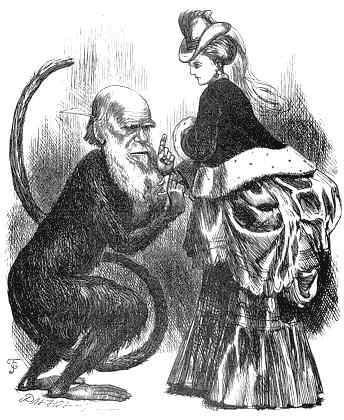
The Origin of Species
Charles Darwin's On the Origin of Species, published on 24 November 1859, is a work of scientific literature which is considered to be the foundation of evolutionary biology. Its full title was On the Origin of Species by Means of Natural Selection, or the Preservation of Favoured Races in the...
, though it was primarily devoted to natural selection. A later work, The Descent of Man and Selection in Relation to Sex dealt with the subject of sexual selection exhaustively, in part because Darwin felt that natural selection alone was unable to account for certain types of apparently non-competitive adaptations, such as the tail of a male peacock. He once wrote to a colleague that "The sight of a feather in a peacock's tail, whenever I gaze at it, makes me sick!" His work divided sexual selection into two primary categories: male-male competition (which would produce adaptations such as a Bighorn Sheep
Bighorn Sheep
The bighorn sheep is a species of sheep in North America named for its large horns. These horns can weigh up to , while the sheep themselves weigh up to . Recent genetic testing indicates that there are three distinct subspecies of Ovis canadensis, one of which is endangered: Ovis canadensis sierrae...
's horns, which are used primarily in sparring with other males over females), and cases of female choice (which would produce adaptations like beautiful plumage, elaborate songs, and other things related to impressing and attracting).
Darwin's views on sexual selection were opposed strongly by his "co-discoverer" of natural selection, Alfred Russel Wallace
Alfred Russel Wallace
Alfred Russel Wallace, OM, FRS was a British naturalist, explorer, geographer, anthropologist and biologist...
, though much of his "debate" with Darwin took place after Darwin's death. Wallace argued that the aspects of it which were male-male competition, while real, were simply forms of natural selection, and that the notion of "female choice" was attributing the ability to judge standards of beauty to animals far too cognitively undeveloped to be capable of aesthetic feeling (such as beetle
Beetle
Coleoptera is an order of insects commonly called beetles. The word "coleoptera" is from the Greek , koleos, "sheath"; and , pteron, "wing", thus "sheathed wing". Coleoptera contains more species than any other order, constituting almost 25% of all known life-forms...
s).
Wallace also argued that Darwin too much favored the bright colors of the male peacock as adaptive without realizing that the "drab" peahen's coloration is itself adaptive, as camouflage
Camouflage
Camouflage is a method of concealment that allows an otherwise visible animal, military vehicle, or other object to remain unnoticed, by blending with its environment. Examples include a leopard's spotted coat, the battledress of a modern soldier and a leaf-mimic butterfly...
. Wallace more speculatively argued that the bright colors and long tails of the peacock were not adaptive in any way, and that bright coloration could result from non-adaptive physiological development (for example, the internal organs of animals, not being subject to a visual form of natural selection, come in a wide variety of bright colors). This has been questioned by later scholars as quite a stretch for Wallace, who in this particular instance abandoned his normally strict "adaptationist" agenda in asserting that the highly intricate and developed forms such as a peacock's tail resulted by sheer "physiological processes" that were somehow not at all subjected to adaptation.
Though Darwin considered sexual and natural selection to be two separate processes of equal importance, most of his contemporaries were not convinced, and sexual selection is usually de-emphasized as being a lesser force than, or simply a part of, natural selection.
The sciences of evolutionary psychology
Evolutionary psychology
Evolutionary psychology is an approach in the social and natural sciences that examines psychological traits such as memory, perception, and language from a modern evolutionary perspective. It seeks to identify which human psychological traits are evolved adaptations, that is, the functional...
, human behavioral ecology
Human behavioral ecology
Human behavioral ecology or human evolutionary ecology applies the principles of evolutionary theory and optimization to the study of human behavioral and cultural diversity. HBE examines the adaptive design of traits, behaviors, and life histories of humans in an ecological context...
, and sociobiology
Sociobiology
Sociobiology is a field of scientific study which is based on the assumption that social behavior has resulted from evolution and attempts to explain and examine social behavior within that context. Often considered a branch of biology and sociology, it also draws from ethology, anthropology,...
study the influence of sexual selection in humans, though these are often controversial fields. The field of epigenetics
Epigenetics
In biology, and specifically genetics, epigenetics is the study of heritable changes in gene expression or cellular phenotype caused by mechanisms other than changes in the underlying DNA sequence – hence the name epi- -genetics...
is broadly concerned with the competence of adult organisms within a given sexual, social, and ecological niche, which includes the development of mating competences, e.g., by mimicking adult behavior.
Criticism
Ecologist Joan Roughgarden criticised sexual selection in a 2006 paper and a follow-up book in 2009 claiming that individuals do not compete strongly for mating opportunities, proposing that the function of sex is mostly social. Sexual selection researchers and evolutionary theorists have heavily criticised these ideas, accusing Roughgarden of factual inaccuracy, unwarranted assumptions, and ignorance of recent research on sexual selection.Ruth Hubbard
Ruth Hubbard
Ruth Hubbard is Professor Emerita of Biology at Harvard University, where she was the first woman to hold a tenured professorship position in biology. -Biography:...
proposed that Darwin's ideas about sexual selection were strongly shaped by Victorian mores and may at times reflect a distinct chauvinistic bias.
Further reading
- Judson, Olivia (2003) Dr.Tatiana's Sex Advice to All Creation: Definitive Guide to the Evolutionary Biology of Sex. ISBN 978-0-09-928375-1
- Jolly, Allison (2001) Lucy's Legacy - Sex and Intelligence in Human Evolution. ISBN 978-0-674-00540-2
- Diamond, Jared (1997) Why is Sex Fun? The Evolution of Human Sexuality. ISBN 978-0-465-03126-9
External links
- Sexual Selection: Stanford University
- The Great Debate: Sexual Selection
- An Introduction to Sexual Selection: University of Siegen
- Intralocus Sexual Conflict Diminishes the Benefits of Sexual Selection
- A New Interpretation of Natural Beauty and Sexual Selection
- Review of GF Miller's The Mating Mind
- The Evolution of Sexual Selection, and its Effect upon Human Behavior

